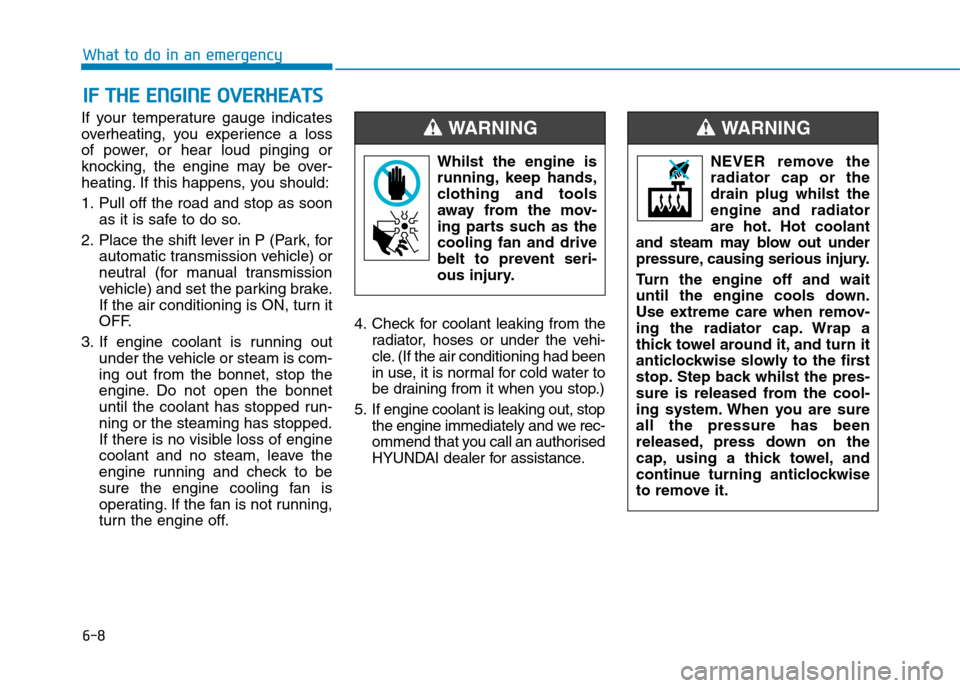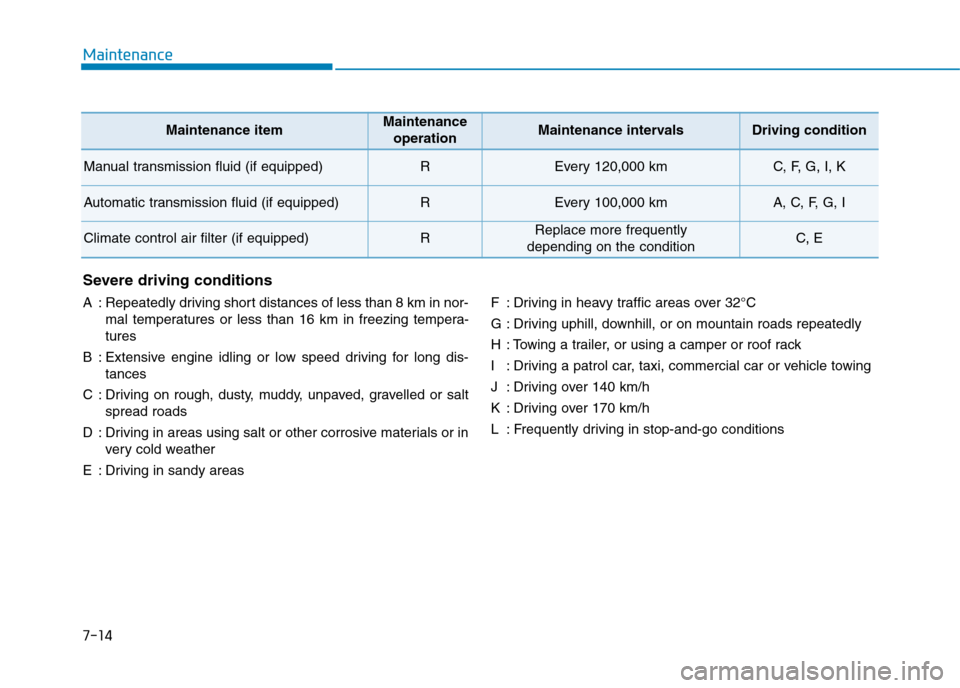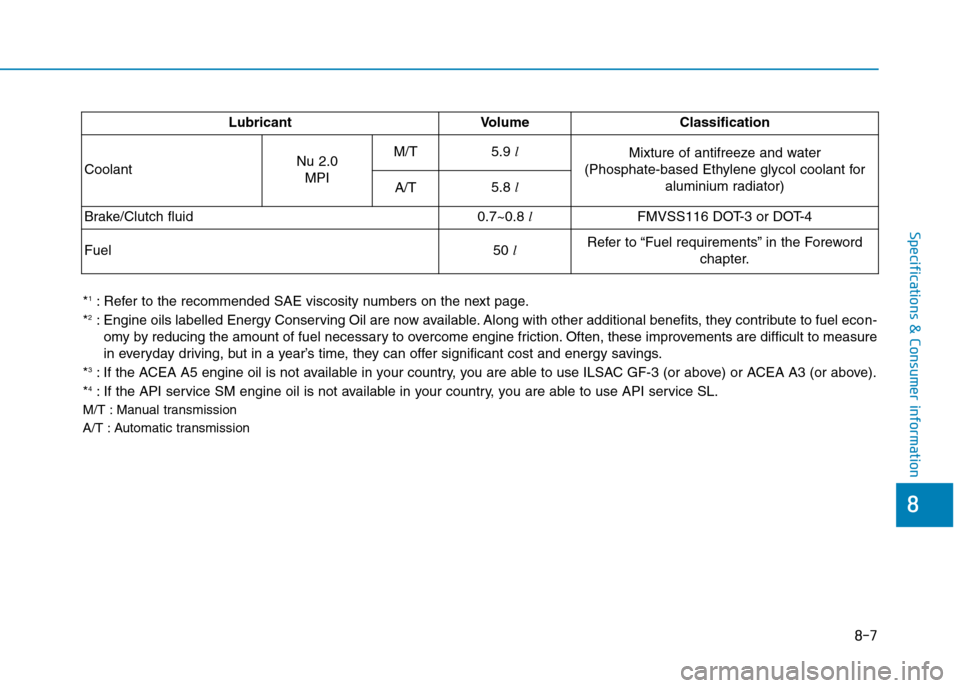Page 452 of 571

6-8
What to do in an emergency
If your temperature gauge indicates
overheating, you experience a loss
of power, or hear loud pinging or
knocking, the engine may be over-
heating. If this happens, you should:
1. Pull off the road and stop as soon
as it is safe to do so.
2. Place the shift lever in P (Park, for
automatic transmission vehicle) or
neutral (for manual transmission
vehicle) and set the parking brake.
If the air conditioning is ON, turn it
OFF.
3. If engine coolant is running out
under the vehicle or steam is com-
ing out from the bonnet, stop the
engine. Do not open the bonnet
until the coolant has stopped run-
ning or the steaming has stopped.
If there is no visible loss of engine
coolant and no steam, leave the
engine running and check to be
sure the engine cooling fan is
operating. If the fan is not running,
turn the engine off.
4. Check for coolant leaking from the
radiator, hoses or under the vehi-
cle. (If the air conditioning had been
in use, it is normal for cold water to
be draining from it when you stop.)
5. If engine coolant is leaking out, stop
the engine immediately and we rec-
ommend that you call an authorised
HYUNDAI dealer for assistance.
IIFF TTHHEE EENNGGIINNEE OOVVEERRHHEEAATTSS
Whilst the engine is
running, keep hands,
clothing and tools
away from the mov-
ing parts such as the
cooling fan and drive
belt to prevent seri-
ous injury.
WA R N I N G
NEVER remove the
radiator cap or the
drain plug whilst the
engine and radiator
are hot. Hot coolant
and steam may blow out under
pressure, causing serious injury.
Tu r n t h e e n g i n e o f f a n d w a i t
until the engine cools down.
Use extreme care when remov-
ing the radiator cap. Wrap a
thick towel around it, and turn it
anticlockwise slowly to the first
stop. Step back whilst the pres-
sure is released from the cool-
ing system. When you are sure
all the pressure has been
released, press down on the
cap, using a thick towel, and
continue turning anticlockwise
to remove it.
WA R N I N G
Page 462 of 571
6-18
What to do in an emergency
Follow these steps to change your
vehicle's tyre:
1. Park on a level, firm surface.
2. Move the shift lever into P (Park,
for automatic transmission vehi-
cle) or neutral (for manual trans-
mission vehicle), apply the park-
ing brake, and place the ignition
switch in the LOCK/OFF position.
3. Press the hazard warning flasher
button.
4. Remove the wheel nut wrench,
jack, jack handle, and spare tyre
from the vehicle.
5. Block both the front and rear of the
tyre diagonally opposite of the tyre
you are changing.
6. Loosen the wheel lug nuts anti-
clockwise one turn each in the
order shown above, but do not
remove any lug nuts until the tyre
has been raised off of the ground.
OAD065006BBBBlllloooocccckkkkOAD065007
Page 482 of 571
7-12
Maintenance
Normal Maintenance Schedule
I:Inspect and if necessary, adjust, correct, clean or replace.
R : Replace or change.
*9:Manual transmission fluid should be changed anytime they have been submerged in water.
Number of months or driving distance, whichever comes first
Months1224364860728496
Km×1,000153045607590105120
Steering gear rack, linkage and bootsIIIIIIII
Driveshaft and bootsIIII
Ty r e ( p r e s s u r e & t r e a d w e a r ) IIIIIIII
Front suspension ball jointsIIIIIIII
Bolt and nuts on chassis and bodyIIIIIIII
Air conditioner refrigerant (if equipped)IIIIIIII
Air conditioner compressor (if equipped)IIIIIIII
Climate control air filter (if equipped)IIIIIIII
Manual transmission fluid (if equipped) *9II
Automatic transmission fluid(if equipped) No check, No service required
Exhaust systemIIII
MAINTENANCE
INTERVALS
MAINTENANCE
ITEM
Page 484 of 571

7-14
Maintenance
Severe driving conditions
A:Repeatedly driving short distances of less than 8 km in nor-
mal temperatures or less than 16 km in freezing tempera-
tures
B:Extensive engine idling or low speed driving for long dis-
tances
C:Driving on rough, dusty, muddy, unpaved, gravelled or salt
spread roads
D:Driving in areas using salt or other corrosive materials or in
ver y cold weather
E:Driving in sandy areas
F:Driving in heavy traffic areas over 32°C
G:Driving uphill, downhill, or on mountain roads repeatedly
H:Towing a trailer, or using a camper or roof rack
I:Driving a patrol car, taxi, commercial car or vehicle towing
J:Driving over 140 km/h
K:Driving over 170 km/h
L:Frequently driving in stop-and-go conditions
Maintenance itemMaintenance
operationMaintenance intervalsDriving condition
Manual transmission fluid (if equipped)REvery 120,000 kmC, F, G, I, K
Automatic transmission fluid (if equipped)REvery 100,000 kmA, C, F, G, I
Climate control air filter (if equipped)RReplace more frequently
depending on the conditionC, E
Page 487 of 571
7-17
7
Maintenance
Manual transmission fluid
(if equipped)
Inspect the manual transmission
fluid according to the maintenance
schedule.
Brake hoses and lines
Visually check for proper installation,
chafing, cracks, deterioration and
any leakage. Replace any deteriorat-
ed or damaged parts immediately.
Brake fluid
Check brake fluid level in the brake
fluid reservoir. The level should be
between “MIN” and “MAX” marks on
the side of the reservoir. Use only
hydraulic brake fluid confor ming to
DOT 3 or DOT 4 specification.
Parking brake
Inspect the parking brake system
including the parking brake lever (or
pedal) and cables.
Brake pads, calipers and
rotors
Check the pads for excessive wear,
discs for run out and wear, and
calipers for fluid leakage.
Suspension mounting bolts
Check the suspension connections
for looseness or damage. Retighten
to the specified torque.
Page 566 of 571
8-5
8
Specifications & Consumer information
TTYYRREE LLOOAADD AANNDD SSPPEEEEDD CCAAPPAACCIITTYY
*1LI : LOAD INDEX*2SS : SPEED SYMBOL
M/T : Manual TransmissionA/T : Automatic Transmission
Item Tyre size Wheel sizeLoad Capacity
LI *1kg
Full size tyre
195/65 R15 6.0J X 15 91 615
205/55 R16 6.5J X 16 91 615
225/45 R177.0J X 1791615
Compact spare tyre (if equipped)T125/80 D154.0T X 1595690
VVOOLLUUMMEE AANNDD WWEEIIGGHHTT
ItemsNu 2.0 MPI
M/TA/T
Gross vehicle weight kg (lbs.)1,800 (3,968)1,820 (4,012)
Luggage volume (VDA)l(cu ft)458 (16.2)
Page 567 of 571
8-6
Specifications & Consumer information
RREECCOOMMMMEENNDDEEDD LLUUBBRRIICCAANNTTSS AANNDD CCAAPPAACCIITTIIEESS
To h e l p a c h i e v e p r o p e r e n g i n e a n d p o w e r t r a i n p e r f o r m a n c e a n d d u r a b i l i t y, u s e o n l y l u b r i c a n t s o f t h e p r o p e r q u a l i t y.
The correct lubricants also help promote engine efficiency that results in improved fuel economy.
These lubricants and fluids are recommended for use in your vehicle.
Lubricant Volume Classification
Engine oil *1*2(drain and refill)
RecommendsNu 2.0
MPI4.0l
API SM*4& ILSAC GF-4 (or above)
ACEA A5*3(or above)
Manual transmission fluidNu 2.0
MPI1.7~1.8
HK MTF 70W (SK)
SPIRAX S6 GHME 70W MTF (H.K.SHELL)
GS MTF HD 70W (GS CALTEX) (API GL-4, SAE 70W)
Automatic transmission fluidNu 2.0
MPI6.7 l
MICHANG ATF SP-IV,
SK ATF SP-IV,
NOCA ATF SP-IV,
HYUNDAI genuine ATF SP-IV
Page 568 of 571

8-7
8
Specifications & Consumer information
Lubricant Volume Classification
CoolantNu 2.0
MPI
M/T5.9 lMixture of antifreeze and water
(Phosphate-based Ethylene glycol coolant for
aluminium radiator)A/T5.8 l
Brake/Clutch fluid0.7~0.8 lFMVSS116 DOT-3 or DOT-4
Fuel50 lRefer to “Fuel requirements” in the Foreword
chapter.
*1:Refer to the recommended SAE viscosity numbers on the next page.
*2:Engine oils labelled Energy Conserving Oil are now available.Along with other additional benefits, they contribute to fuel econ-
omy by reducing the amount of fuel necessary to overcome engine friction. Often, these improvements are difficult to measure
in everyday driving, but in a year’s time, they can offer significant cost and energy savings.
*3:If the ACEA A5 engine oil is not available in your country, you are able to use ILSAC GF-3 (or above) or ACEA A3 (or above).
*4:If the API service SM engine oil is not available in your country, you are able to use API service SL.
M/T : Manual transmission
A/T : Automatic transmission